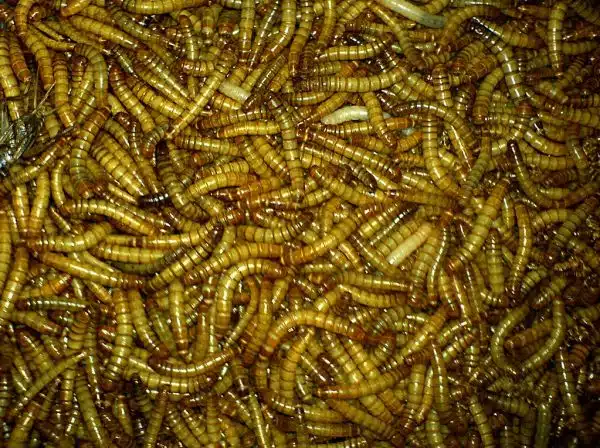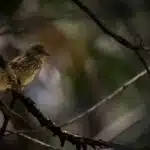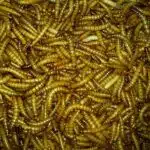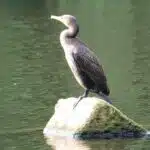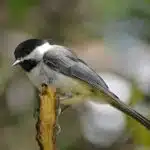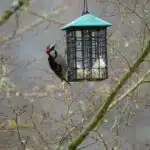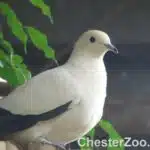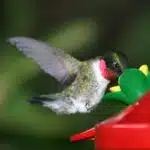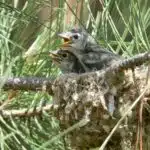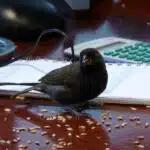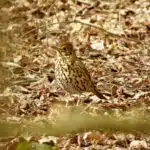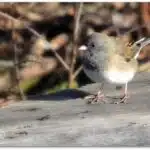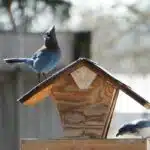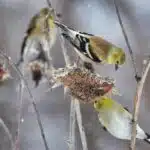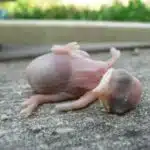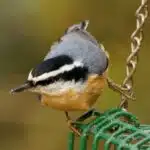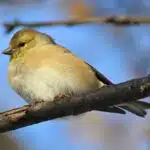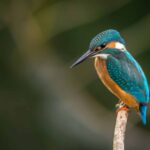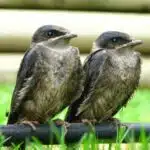The American robin is a familiar bird, with its bright red breast and melodic song. Robins are also known for their voracious appetite for earthworms, which makes up the majority of their diet during breeding season. However, finding worms can be a challenging task, and robins have developed sophisticated strategies to locate them.
As wildlife research scientists, we have studied the behavior of robins in their search for food. Through our research, we have uncovered fascinating insights into how these birds find worms and navigate their environment. Furthermore, we have identified ways in which humans can help robins by creating habitats that support the growth of earthworm populations. In this article, we will explore the remarkable strategies that robins use to find worms and provide practical tips on how you can support these feathered friends in your own backyard.
The Importance Of Earthworms In The Robin’s Diet
The robin’s diet is primarily composed of insects and their larvae, but earthworms are a crucial part of their daily intake. Earthworms provide essential nutrients such as protein, fat, and calcium that are necessary for the development and maintenance of healthy muscles, bones, and feathers. Additionally, earthworms contain digestive enzymes that enhance the robin’s digestive system and reduce the risk of diseases. Therefore, it is no surprise that conservation efforts for robin populations emphasize the importance of preserving earthworm habitats.
Earthworms are also beneficial to soil health and plant growth. Their burrowing activities improve soil structure and drainage while adding organic matter to the soil. Furthermore, earthworm castings (excrement) contain high levels of nitrogen, phosphorus, potassium, and other minerals that are vital to plant growth. By consuming earthworms, robins contribute to a healthy ecosystem in which plants thrive.
Despite the benefits of earthworms in the robin’s diet, finding them can be challenging. Earthworms typically reside underground during the day and only come out at night or after rainfall. Robins have evolved to detect worms through visual cues such as movement on the ground or changes in soil moisture levels caused by worm activity. However, these cues can be unreliable at times due to environmental conditions such as drought or freezing temperatures. In the next section, we will explore some strategies robins use to overcome these challenges when searching for worms.
The Challenges Of Finding Worms
- The competition among robins for finding worms is intense; they are often found in groups, competing for food.
- The limited visibility of worms due to their burrowing habits presents a challenge for robins as they must actively search for food.
- The unpredictable availability of worms further complicates the search, as they may not be in the same place each day.
- To aid robins in their hunt for worms, providing bird feeders with mealworms or setting up a worm compost bin can help supplement their diet.
Competition
As wildlife research scientists, we often observe how predators and prey interact. One fascinating example is how robins find worms amidst stiff competition from other birds and animals. These worms are their primary source of food, and their survival depends on the ability to locate them quickly and efficiently.
Competition in finding worms has led to the evolution of unique strategies among different bird species. Some birds rely on visual cues, while others use their sense of hearing or smell to detect worms. The robin’s strategy involves listening for earthworms moving through soil or grass, which they can then pinpoint accurately using their vision. This evolutionary strategy gives them an advantage over other birds that only use one sense.
Despite these evolutionary advantages, the competition for worms remains fierce. As humans continue to alter habitats by removing green spaces and introducing non-native species, robins face new challenges in finding enough food to survive. We can help by creating bird-friendly gardens that provide a natural habitat for earthworms and other insects that robins depend on for sustenance. By serving as stewards of our environment, we can support these beautiful birds while also promoting biodiversity in our communities.
Limited Visibility
As wildlife research scientists, we are constantly studying the interactions between predators and prey. One of the most fascinating examples is how birds find worms in their natural habitats. While some birds rely on visual cues or their sense of smell to locate worms, others have adapted to darkness and use their exceptional hearing abilities to pinpoint these elusive creatures. However, even with these evolutionary strategies, finding worms can be a challenge for birds, especially in areas with limited visibility.
Birds that have adapted to darkness often use different techniques to locate worms. For instance, they may have larger eyes or more rods in their retinas that allow them to see better in low light conditions. Additionally, some bird species have developed camouflaging techniques that help them blend into their surroundings and avoid detection by predators. Despite these adaptations, finding worms in the dark remains challenging because of the limited visibility.
Limited visibility can pose a significant challenge for birds that depend on finding worms for survival. In urban environments where green spaces are scarce or non-existent, this problem is compounded as artificial light sources can disrupt natural cycles and impact bird behavior. As stewards of our environment, we can take steps to minimize light pollution and create bird-friendly gardens that provide a natural habitat for earthworms and other insects that birds depend on for sustenance. By doing so, we can help these beautiful creatures adapt to changing conditions while promoting biodiversity in our communities.
Visual Cues For Worm Detection
Robins have an incredible sense of sight that allows them to detect worms from a distance. They use several visual cues to locate their prey, including changes in soil color and movement on the ground. However, recent developments in technology have enabled scientists to gain further insight into how these birds locate their food.
Using technology such as thermal imaging cameras and GPS trackers, researchers are now able to track the migration of earthworms. This information can be used to help robins find new sources of food during times of scarcity. Additionally, studies have shown that robins are able to detect ultraviolet light, which is invisible to humans. This ability helps them identify changes in soil color caused by worm activity.
Worm detection is critical to the survival of robins, particularly during nesting season when they require large quantities of protein-rich food for their young. By understanding the visual cues used by these birds, we can help create environments that are more conducive to their survival. For example, maintaining healthy soil with abundant earthworm populations can provide a reliable food source for robins and other insectivorous birds.
Transition: While visual cues are important for worm detection, auditory cues also play a crucial role in helping robins locate their prey. Let’s explore this further in the next section about auditory cues for worm detection.
Auditory Cues For Worm Detection
Training robins to locate worms through visual cues is a common practice. However, studies have shown that robins also rely on auditory cues for worm detection. Sound localization, or the ability to determine the location of a sound source, is crucial for birds as they navigate their environment and locate prey. For robins, this means using their excellent hearing abilities to detect and pinpoint the location of earthworms.
Robins use various auditory cues to locate worms. One of the most important cues is the sound of earthworms burrowing through soil and leaf litter. This sound is created by friction between the worm’s body and surrounding soil and can be heard by robins from several meters away. Another cue is the sound of worms moving within burrows underground. Robins can hear these sounds with incredible precision, thanks to their highly developed auditory system.
To help support robins in locating worms based on auditory cues, it’s important to provide an environment that allows for optimal hearing conditions. This includes minimizing background noise pollution such as traffic or machinery sounds that can interfere with a robin’s ability to detect earthworm sounds. Additionally, planting vegetation that provides cover for worms and other prey species can help attract more food sources for robins while also creating an ideal habitat for these birds.
Transitioning into the subsequent section about olfactory cues for worm detection: While sound localization plays a critical role in how robins locate prey, it’s not the only sense they rely on. In fact, research has shown that olfactory cues may also be important in worm detection. Let’s take a closer look at how these birds use their sense of smell to find food in our next section.
Olfactory Cues For Worm Detection
Robins use a combination of sensory cues to locate worms, including auditory and olfactory cues. In the previous section, we discussed how robins use their keen sense of hearing to detect the sound of worms moving in the ground. However, auditory cues are not the only way robins find their prey.
Olfactory cues also play a significant role in worm detection for robins. Robins have a well-developed sense of smell that allows them to detect chemical signals that emanate from earthworms. These chemical signals are produced by compounds in the worm’s mucus and excretions. By using olfactory training, robins can learn to associate these chemical signals with the presence of worms, making it easier for them to locate their prey.
In addition to being fascinating creatures to observe, robins play an important role in pest control. Their diet consists primarily of insects and other small invertebrates, many of which can be detrimental to human crops and gardens. By understanding how robins locate their prey, we can better appreciate their contribution to natural pest control and find ways to encourage their presence in our yards and gardens.
As we continue our exploration into how robins find worms, we will discuss another important aspect: using tools to locate prey. While many birds are known for using tools such as sticks or rocks to extract food from crevices or hard-to-reach areas, researchers have yet to observe this behavior in robins specifically related to locating worms. However, this does not mean that they do not use some form of tool when hunting for prey. We will explore this topic further in the next section.
Using Tools To Locate Worms
- Surveillance cameras can be used to observe and track the seasonal movements of worms and their habitats.
- Night vision goggles can be used to identify worms more easily in low light conditions.
- Metal detectors can be used to detect the presence of worms in soil and other media.
- Mole maps can be used to identify the concentration of worms in specific areas and help to interpret the data.
Surveillance Cameras
To better understand how robins locate their food, the use of surveillance cameras has proven to be a valuable tool for wildlife researchers. Surveillance cameras allow for 24/7 monitoring of robin behavior and provide an unobtrusive way to observe them in their natural habitat. The benefits of using surveillance cameras are numerous, as they can capture footage that can be analyzed to determine the frequency and location of worm sightings.
However, the use of surveillance cameras also raises concerns about privacy. While robins may not have a concept of privacy, it is important to consider the ethical implications of using these tools. Researchers must obtain proper permits and adhere to guidelines set forth by governing bodies to ensure that the use of surveillance cameras is done responsibly and with minimal impact on the birds’ well-being.
Despite these concerns, the benefits of using surveillance cameras far outweigh any potential drawbacks. With this technology, we can gain valuable insights into how robins find worms and develop strategies for habitat conservation that benefit both birds and humans alike. As we continue to explore new ways to study wildlife behavior, it is important that we do so thoughtfully and with an eye towards preserving our planet’s biodiversity.
Night Vision Goggles
As wildlife researchers, we are constantly looking for innovative ways to study animal behavior. One tool that has recently gained popularity is night vision technology, which allows us to observe animals in their natural habitat during the nighttime hours. With this technology, we can gain valuable insights into how animals behave when they think no one is watching.
When it comes to locating worms, night vision goggles can be particularly useful. Many species of birds and other animals prefer to hunt for worms at night when they are more active and easier to spot. By using binoculars with night vision capabilities, researchers can observe these creatures as they search for their prey without disrupting their natural behavior patterns.
Of course, not all night vision equipment is created equal. When selecting binoculars for use in wildlife research, it is important to choose a model that offers high-quality optics and reliable performance in low-light conditions. By doing so, we can ensure that our observations are accurate and our data is reliable, allowing us to make informed decisions about conservation efforts and other wildlife management initiatives.
The Role Of Memory In Worm Finding
Memory retention plays a vital role in the success of robins in finding worms. Their cognitive process involves the ability to remember visual cues, such as color and texture of the soil, as well as the location where they previously found food. Robins are known to have excellent spatial memory and can accurately recall the exact location of their food source even after several weeks.
Studies have shown that memory retention in robins is influenced by various factors such as age, experience, and environmental conditions. Juvenile robins tend to have lower memory retention compared to adults due to their limited exposure to different environments. On the other hand, adult robins with years of experience have developed a better cognitive process that allows them to efficiently locate food sources.
Understanding how robins utilize memory retention in their search for worms can help us provide suitable habitats for these birds. By creating an environment that mimics their natural habitat and providing bird feeders with live worms or insects, we can help sustain the population of these birds while also enjoying their presence in our surroundings.
As we continue to study the cognitive processes of robins, we gain insight into how these birds navigate their environment. The next section will focus on how robins use sensory information such as sight and sound to locate potential food sources while flying and landing.
Navigating The Environment
The environment is a complex web of relationships where animals and plants have adapted to survive. Robins, for example, rely on their sensory adaptations to navigate their surroundings. They use environmental cues such as the quality of light and magnetic fields to locate worms. Their visual system has evolved to detect the slightest movement on the ground, which helps them identify earthworms moving through the soil.
To better understand how robins find worms, we need to look at their sensory systems. The eyesight of birds is highly specialized and allows them to see colors that humans cannot perceive. In addition, they have a high number of rods and cones in their retina, which enhances their ability to see in low light conditions. Moreover, birds can detect magnetic fields using specialized iron-containing cells called magnetoreceptors located in their eyes.
Environmental cues play a crucial role in helping robins locate earthworms. For instance, they rely on changes in air pressure before it rains to find worms that come out of the ground. Another cue is scent; robins use olfactory cues from the soil to identify areas with high concentrations of earthworms. By understanding these sensory adaptations and environmental cues, we can create habitats that support these birds’ abilities to find food easily.
- The availability of trees and shrubs provides shelter for birds and increases biodiversity.
- Creating small ponds or water sources provides drinking water for birds.
- Planting native flowers or crops attracts insects like earthworms which are an essential part of a bird’s diet.
By creating an environment that supports wildlife through habitat restoration efforts, we can ensure that birds like robins continue to thrive while also benefiting our communities as a whole by promoting healthy ecosystems. To further support this effort, creating a habitat for earthworms within your garden or green space will provide additional resources for robins while also improving soil health.
Creating A Habitat For Earthworms
The creation of a habitat for earthworms is an essential step in maintaining the health of soil and promoting positive environmental changes. Earthworms play a vital role in the ecosystem, breaking down organic matter and aerating the soil. By providing a suitable environment for earthworms to thrive, gardeners can reap the benefits of improved soil quality, such as increased water retention and nutrient availability.
One way to create a suitable habitat for earthworms is by adding organic matter to the soil. Composting benefits not only provide food for earthworms but also introduces beneficial microorganisms that promote soil health. Additionally, composting helps reduce waste and can be done on a small or large scale depending on one’s needs. The resulting compost can then be added to garden beds or used as top dressing around plants.
In summary, creating a habitat for earthworms is crucial in promoting soil health and improving environmental conditions. Incorporating composting into one’s gardening routine provides numerous benefits while also supporting earthworm growth. By taking these steps, gardeners can help maintain healthy ecosystems while reaping the rewards of flourishing gardens. The next section will explore how composting techniques can further benefit the growth of earthworm populations.
Composting For Earthworm Growth
Creating a Habitat for Earthworms is one of the first steps towards vermicomposting benefits. By providing earthworms with a suitable habitat, you are promoting their growth and reproduction. Earthworms require moist soil that is rich in organic matter to thrive. It is important to avoid using pesticides and chemical fertilizers as they can harm earthworms and other beneficial soil organisms.
Vermiculture techniques involve feeding earthworms with organic waste materials such as food scraps, yard waste, and shredded paper. Earthworms consume the organic matter and convert it into nutrient-rich castings or vermicompost. Vermicompost has many benefits for plants as it improves soil structure, increases water retention, and enhances plant growth.
To start vermicomposting, you will need to set up a worm bin. A worm bin can be made from a plastic container or purchased commercially. The worm bin should have adequate drainage holes and ventilation to ensure proper air flow. You can add bedding material such as shredded newspaper or leaves to the worm bin along with some food scraps to get started.
- Vermicomposting reduces greenhouse gas emissions by diverting organic waste from landfills.
- Vermicompost has been shown to suppress plant diseases.
- Earthworm activity can improve soil health by increasing microbial activity.
By following vermiculture techniques, you can produce your own nutrient-rich compost while reducing waste in landfills. Providing earthworms with a suitable habitat will promote their growth and reproduction while improving soil health. Remember to avoid pesticides and chemical fertilizers when creating a habitat for earthworms as they can harm beneficial soil organisms.
Avoiding Pesticides And Chemical Fertilizers
The use of pesticides and chemical fertilizers in gardening has become increasingly prevalent over the years. These chemicals are designed to eliminate pests and increase crop yields, but they come with a significant cost to the environment and wildlife. Pesticides can be toxic to birds like robins, who may consume contaminated insects or worms, leading to illness or death.
Organic gardening offers an alternative solution that promotes healthy soil and plants without the use of harmful chemicals. By using natural methods such as composting, crop rotation, and companion planting, gardeners can create a thriving ecosystem that supports wildlife like robins. Organic gardening also has long-term benefits for the soil by promoting biodiversity and reducing erosion.
The environmental impact of avoiding pesticides and chemical fertilizers cannot be overstated. By choosing organic gardening methods, we can help protect our planet’s delicate ecosystems while providing safe habitats for wildlife like robins. Alternative solutions may require more effort initially but offer lasting benefits that far outweigh any short-term gains from using chemicals.
Providing Water Sources
Creating bird-friendly water sources involves understanding the needs of local birds, as well as the habitat in which they live. Locating suitable water sources can be challenging, as birds require access to clean, shallow water that is protected from predators. Maintenance of bird-friendly water sources is also important, as regular cleaning and refilling is necessary to prevent the spread of bacteria and parasites. Finally, providing birds with an adequate food source near the water sources is essential to ensure the birds will frequent the area.
Creating Bird-Friendly Water Sources
Birds need water to survive, especially during the hot summer months. Creating bird-friendly water sources is important for attracting birds and providing them with the necessary hydration they need to thrive. As a wildlife research scientist, I recommend DIY bird baths as an effective way to provide a water source for birds.
DIY bird baths are easy to make and can be placed in your garden or backyard. To create a DIY bird bath, simply find an old bowl or dish and place it on top of a stand or pedestal. Fill the bowl with fresh water and add some drought-resistant plants around the base of the stand. This will not only provide birds with much-needed hydration, but it will also attract other wildlife such as butterflies and bees.
In addition to DIY bird baths, planting drought-resistant plants in your garden can also benefit birds by providing them with a source of food and shelter. These plants require less water than traditional plants, making them ideal for dry climates. By incorporating these simple steps into your outdoor space, you can help create a more bird-friendly environment while also conserving water during times of drought.
Finding And Maintaining Water Sources
As a wildlife research scientist, it is important to understand the role of water in the survival of birds. While providing DIY bird baths and planting drought-resistant plants are effective ways to provide hydration and food sources for birds, finding and maintaining water sources is equally important.
Conservation efforts can be made by identifying natural water sources such as ponds, streams, or lakes that are near bird habitats and ensuring they are well-maintained. This includes regular cleaning of debris and pollutants, monitoring water levels during times of drought, and avoiding the use of harmful chemicals that can contaminate the water source. Providing clean and safe drinking water not only benefits birds but also other wildlife that rely on these natural resources.
Water conservation techniques can also be implemented by using rainwater harvesting systems or installing drip irrigation systems in gardens. These methods reduce the amount of water used while still providing necessary hydration for birds and plants. Additionally, reducing lawn areas and replacing them with native vegetation can further conserve water while creating a more suitable habitat for birds. By incorporating these conservation efforts into our daily lives, we can ensure that our feathered friends have access to clean and abundant sources of water for years to come.
Planting Native Vegetation
Native vegetation benefits robins in several ways. First, it provides them with a natural habitat where they can find food and shelter. Native plants are adapted to local soil and climate conditions, which means they require less water and maintenance than non-native ones. This makes them ideal for creating a sustainable ecosystem that supports wildlife.
To attract robins to your yard, you should consider planting native vegetation. This can be done using various planting techniques such as seeding or transplanting. Before starting, it’s important to research which species are indigenous to your area and what their growing requirements are. You may also want to consult with a local horticulturist or conservation organization for advice on how to create a bird-friendly habitat.
Planting native vegetation is not only beneficial for robins but also for other wildlife species that rely on these plants for survival. By creating a diverse landscape of trees, shrubs, grasses, and flowers, you’ll be providing essential resources such as food, nesting sites, and cover from predators. Moreover, you’ll be contributing to the conservation of biodiversity in your community.
As we’ve seen, planting native vegetation is an effective way of attracting robins to your yard while supporting local wildlife populations. In the next section, we’ll explore another method of encouraging robin presence: building nesting boxes. Nesting boxes provide an additional resource for robins seeking safe places to lay eggs and raise their young. By following the steps outlined in the next section, you can help create a thriving robin population in your area.
Building Nesting Boxes
Planting native vegetation is a great way to attract robins to your backyard. However, providing them with a suitable nesting spot is just as crucial. Did you know that eastern bluebirds, a close relative of robins, have declined by 90% in the last century due to habitat loss? Building nesting boxes can help combat this decline and provide a safe space for robins to raise their young.
To build a nesting box, you will need some basic materials such as untreated wood, screws, and a drill. A DIY guide can be found online or at your local hardware store. It’s important to follow the instructions carefully as improper construction may lead to nest failure or injury to the birds. Once constructed, placement is key. Nesting boxes should be mounted on poles at least five feet off the ground and away from high traffic areas such as bird feeders.
Best practices for monitoring and maintaining nesting boxes include checking for predators such as snakes or raccoons and cleaning out old nests once breeding season has ended. Celebrate success when you see robins using the nesting box by observing from afar and avoiding disturbing them during this critical time. With proper care and attention, your efforts in providing suitable nesting spots can boost robin populations in your area while also serving as an educational opportunity for others to do their part in conservation efforts.
Monitoring And Celebrating Success
As wildlife research scientists, we understand the importance of monitoring progress and celebrating milestones. When it comes to helping robins find worms, tracking our efforts is key to evaluating the success of our actions. We can do this by keeping a record of the number of worms we provide or observing how frequently the robins visit our feeding stations.
Sharing success stories is another effective way to celebrate progress. By sharing our experiences with others, we can inspire them to take action and contribute to the cause. This could involve sharing photos or videos of robins enjoying their meals or discussing how our actions have positively impacted local ecosystems.
Ultimately, celebrating success is about recognizing the positive impact that we can have on the world around us. Whether you are an individual making small changes in your backyard or part of a community initiative, every effort counts. By monitoring progress and sharing success stories, we can continue to make a difference for robins and other species that rely on us for survival.
Conclusion
Robins are beloved birds that can be found throughout North America, and they rely heavily on earthworms as a primary food source. However, finding these elusive prey items can be a challenge, especially during dry or cold weather. Fortunately, there are several ways that humans can help robins find the worms they need to survive.
Visual cues such as movement and color contrast can help robins detect worms on the ground, while auditory cues such as rustling leaves or wriggling sounds can also give away their presence. Additionally, robins have a keen sense of smell and can use their olfactory senses to locate worms underground. By providing water sources for earthworms and planting native vegetation to support healthy soil ecosystems, humans can encourage more worms to thrive in areas frequented by robins. Building nesting boxes can also provide safe havens for robin families.
According to a recent study, one robin family alone can consume up to 14 feet of earthworms per day during breeding season. That’s enough to stretch from the ground to the top of a telephone pole! By taking steps to support healthy soil ecosystems and attract earthworms to their yards and gardens, humans can play an important role in helping these iconic birds thrive. As wildlife research scientists continue to learn more about how robins find their food and what they need to survive, we can all do our part to contribute to their success.
Image Credits
- “worms” by Wahj (featured)

